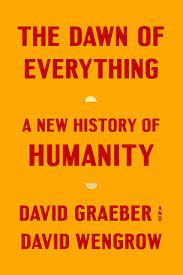
In my recent study of ancient civilizations, I bought this huge book – “The Dawn Of Everything – A New History Of Humanity”, by David Graeber and David Wengrow.
This was a completely different type of read for me; Graeber and Wengrow are anthropologists and archeologists, and write as such. I don’t know a lot about Wengrow, but Graeber (who passed in 2020)
was a founder of the “Occupy” movement, and a prolific writer.
Graeber’s Wikipedia page is quoted here:
“In November 2011, Rolling Stone credited Graeber with giving the Occupy Wall Street movement its theme: “We are the 99 percent”. Graeber wrote in The Democracy Project that the slogan “was a collective creation”.
Graeber argued that the Occupy Wall Street movement’s lack of recognition of the legitimacy of either existing political institutions or the legal structure, its embrace of non-hierarchical consensus decision-making and of prefigurative politics made it a fundamentally anarchist project.”
In this sense, “The Dawn Of Everything” might just be Graeber’s “Homage” to the “Occupy” movement.
The book essentially begins with a comparison of early European philosophy, especially as it related to the sociology of indigenous people in the Americas. For instance, it opens with a comparison of Jacques Rousseau’s theories about the perceived social equality of “The Noble Savage” – up to the introduction of agriculture – compared to Thomas Hobbes’s theory that the “original state of nature was in no sense innocent; it must instead have been “solitary, poor, nasty, brutish and short”.
The authors proceed to state classic analysis of ancient civilizations, and then tear that analysis down, introducing new evidence, concepts and ideas. For instance, they introduce the concept of “play agriculture”, in which primitive cultures dabbled with organized agriculture only seasonally if at all.
The authors also give much credit to women, who innovated weaving and sewing and were the primary drivers of processing food, leading to agriculture.
The authors touch on other civilizations that I have read about, the hidden and unexplained structures such as Gobekli Tepe and other neolithic sites, without attempting to decode exactly what they were.
They do not however, pull any punches as to the level of violence and possible cannibalism in such societies.
This is somewhat of a quest to determine when equality began, more to say it may have never existed.
The book is massive, but don’t let that turn you away. Though written by social scientists, it reads well and provides much food-for-thought. If you are looking for a broad perspective on the history of humanity, this might be your book. However, it is plainly that – a broad perspective. The book jumps around quite a bit but seemingly always circles back to the Rousseau-Hobbes dialectic.
-John Titus

